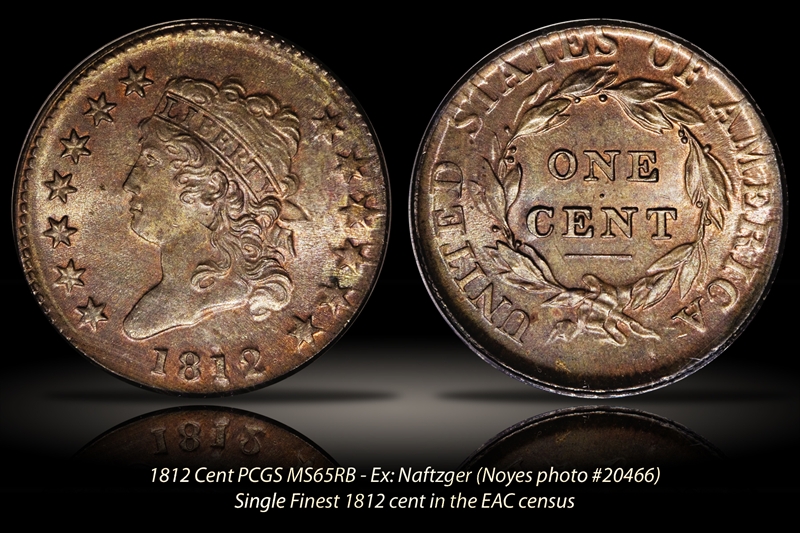1812 1C S-290 Small Date, BN MS65+ BN 认证号07423549, PCGS号36499
拥有者评论
With the Draped Bust design, the Mint was finally producing coinage acceptable to the public, lasting entirely through the tenures of Mint Directors Henry William DeSaussure and Elias Boudinot. When Robert L. Patterson assumed that position in 1805, however, the Mint was facing new problems - the production of new denominations of coins. Congress was genuinely debating the addition of 2-cent pieces and 20-cent pieces to America's circulating coinage. Expecting that approval of the new denominations was imminent, Mint Director Patterson began preparations. By that time engraver Robert Scot was not up to the task of creating truly original designs, and so Patterson looked elsewhere. On April 1, 1807, Johann Matthaus 'John' Reich was appointed as the Mint's new engraver, and he immediately set about generating his new designs. As it would turn out, Reich's designs represented a complete "about face" for America's coinage, quite literally: for each denomination, the long-standing right-facing portraits of Liberty were replaced with left-facing portraits. Starting in 1807 and ultimately sweeping through all of the denominations, Reich's design portrayed Liberty as a rather portly woman, derided as the "artist's fat mistress." The model for Reich's work is not known and no sketches remain, so perhaps the artist was simply expressing his own views of beauty from his upbringing in his native Germany. For the silver and gold denominations, Reich's Liberty wore a turban cap. These are typically called the "capped bust" or "turban" design.-------------------------**For the half-cents and large cents, however, Miss Liberty simply wore a ribbon in her hair, with "LIBERTY" inscribed upon it. Nonetheless, the association with the turban head denominations caused these cents to be labeled as Turban Head cents as early as Edouard Frossard's Monograph published in 1879, and the term is still used by some numismatists today.-----------------------------**Still, for the large cents Miss Liberty does NOT actually wear a cap or turban, so truly it is a misnomer, and most authorities (including PCGS) now refer to the design as the "Classic Head," a term coined by 19th century dealer Ebenezer Locke Mason in his Magazine in February, 1868.-----**Reich's Classic Head cents remained in production for just a short time, from 1808 through 1814. Unfortunately, this time period coincided with unusually poor quality planchets supplied to the Mint for coining, and so the typical surviving Classic cent is likely to be unusually dark, rough, porous, unattractive, or what copper experts label as "scudzy." Consequently, attractive high-grade survivors are particularly scarce. The Collection includes such a piece, a wonderfully attractive gem from 1812, acknowledged by the EAC as the single finest known 1812 cent. Featuring a very strong (though not full) strike, this specimen displays lovely smooth milk chocolate brown surfaces, with ample mint red and superb luster.
PCGS #
36499
设计师
John Reich
边缘
Plain
直径
28.00 毫米
重量
10.89 克
铸币数量
1075500
金属成分
Copper
更高评级数量
0
评级较低的钱币数量
17
地区
The United States of America
价格指南
PCGS 数量报告
拍卖 - PCGS 评级的
拍卖 - NGC 评级的

























